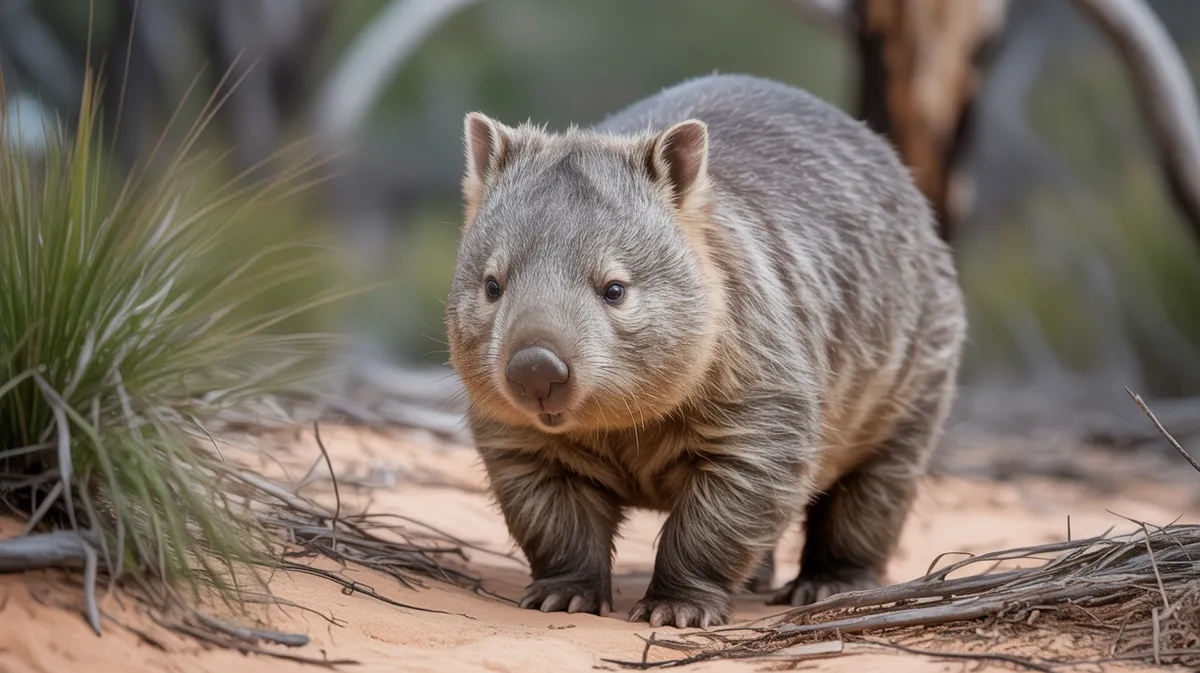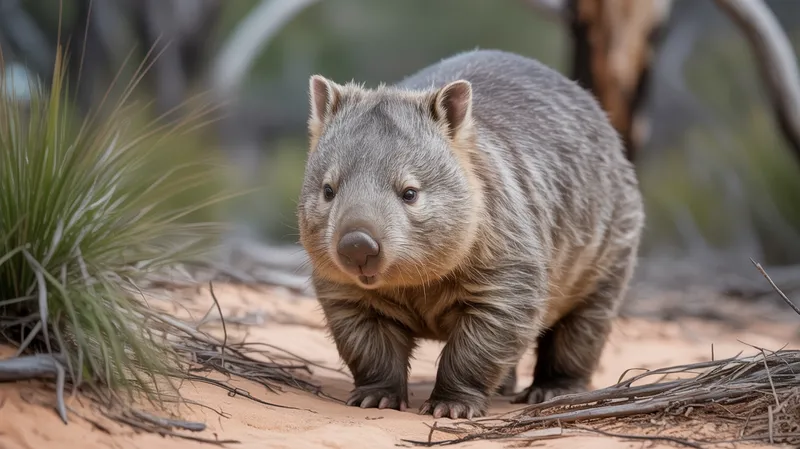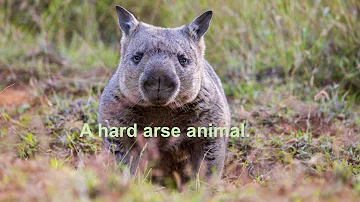
Wombat (Northern Hairy-nosed)
Lasiorhinus krefftii

Meet the Wombat (Northern Hairy-nosed)
The Northern Hairy-nosed Wombat is one of the world’s rarest large mammals and is distinguished by its soft, grey fur, pointy ears, and the presence of fine hairs on its nose. This robust marsupial is a powerful digger, creating extensive burrow systems in sandy soils. Once widespread in eastern Australia, it now survives only in a single protected reserve in central Queensland. The species is nocturnal and highly secretive, emerging at dusk to graze on native grasses and herbs.
Classification
Mammal
Habitat
Eucalypt woodland with sandy soils and native grass understorey
Diet
Herbivore
Lifespan
15-28 years
Conservation
Critically Endangered
Weight
25-40 kg
📖Fascinating Facts
Marsupial Digger
The Northern Hairy-nosed Wombat is a marsupial that digs elaborate burrow systems to escape extreme weather and predators.
Grass Connoisseur
Its diet consists almost entirely of native grasses, and it has evolved tough molars that grow continuously to handle the abrasive vegetation.
Ultra Rare
This species is considered one of the rarest land mammals on Earth, with its population protected by round-the-clock monitoring and predator-proof fencing.
📋Detailed Description
The Northern Hairy-nosed Wombat (Lasiorhinus krefftii) is a robust, burrowing marsupial distinguished by its soft, dense grey fur, broad flattened head, and prominent, forward-facing ears. Adults typically measure 90–110 cm in length and weigh between 25–40 kg, making them the largest of all wombat species. Their most distinctive feature is the presence of fine, sensory hairs on the nose, which aid in detecting food and navigating in low-light conditions. The species has short, powerful limbs equipped with strong claws, perfectly adapted for digging extensive burrow systems that can reach up to 3.5 meters deep and 20 meters long. Their teeth are ever-growing, an adaptation to their fibrous diet. Northern Hairy-nosed Wombats are primarily nocturnal and solitary, emerging from their burrows at dusk to graze on native grasses, particularly favoring species such as Dichanthium sericeum (bluegrass). They possess a backward-facing pouch to prevent soil from entering while digging. Social interactions are minimal, with individuals maintaining exclusive home ranges, though several wombats may share a burrow system at different times. The species is highly secretive, rarely seen in the wild, and relies on acute hearing and olfactory senses to detect predators and conspecifics. Their current range is restricted to the Epping Forest National Park in central Queensland, where intensive management supports the last remaining population.
💡 Did you know?
Fewer than 350 Northern Hairy-nosed Wombats remain in the wild, all confined to a single national park in Queensland, Australia.
🔬Research & Sources
🎭Behavior & Social Structure
Northern Hairy-nosed Wombats are predominantly nocturnal, spending the day in deep, cool burrows to avoid the heat and conserve moisture. They emerge at dusk to feed, often traveling several hundred meters from their burrows in search of preferred grasses. Foraging is primarily solitary, and individuals are highly territorial, marking their home ranges with scent glands located on their chests. Social interactions are rare and generally limited to brief encounters at burrow entrances or during the breeding season. Wombats communicate through scent marking, vocalizations (such as grunts and hisses), and occasionally through physical displays. They are known for their methodical grazing, using their sensitive noses to select the most nutritious shoots. During droughts or food scarcity, they can reduce their activity and metabolic rate to conserve energy and water.
👶Reproduction & Life Cycle
Breeding in the Northern Hairy-nosed Wombat is seasonal, with most births occurring between November and April, coinciding with the wet season and increased food availability. Females are polyestrous but typically produce only one offspring every two years due to the extended period of maternal care. After a gestation period of approximately 21 days, a single joey is born and immediately crawls into the mother's backward-facing pouch, where it remains for about 8–9 months. After leaving the pouch, the young continues to suckle and stay close to the mother for an additional 3–6 months before becoming fully independent. Sexual maturity is reached at around 3 years of age. Parental care is exclusively maternal, and reproductive rates are low, contributing to the species' vulnerability.
🛡️Adaptations & Survival
Northern Hairy-nosed Wombats exhibit several specialized adaptations for survival in arid and semi-arid environments. Their extensive burrowing behavior provides thermal refuge from extreme temperatures and protection from predators. The backward-facing pouch prevents soil from contaminating the young during digging. Their ever-growing incisors and robust jaw muscles are adapted for processing tough, fibrous grasses. Physiologically, they have a low metabolic rate and efficient water reabsorption in the colon, allowing them to survive on dry forage and limited water. Their keen sense of smell and hearing compensate for poor eyesight, aiding in nocturnal foraging and predator detection. The fine hairs on their noses enhance tactile sensitivity, crucial for locating food in low-light conditions.
📚Research Sources
🎨Cultural Significance
Unlike the Common Wombat, the Northern Hairy-nosed Wombat has limited direct representation in Aboriginal mythology or Australian folklore, likely due to its historical rarity and secretive nature. However, it has become a symbol of conservation efforts in Australia, representing the plight of critically endangered species. The species features in educational programs and conservation campaigns, raising awareness about habitat protection and biodiversity. There are no known traditional uses or significant roles in indigenous culture, but its survival is now closely tied to national and international conservation identity.
🔬Recent Research & Discoveries
Recent research on the Northern Hairy-nosed Wombat has focused on genetic diversity, population monitoring, and reproductive biology. Advances in non-invasive genetic sampling (using hair and fecal DNA) have allowed scientists to estimate population size and monitor individual health without disturbance. Studies have revealed alarmingly low genetic diversity, prompting the establishment of a second population at the Richard Underwood Nature Refuge in 2009 to reduce extinction risk. Radio-tracking and camera traps have provided insights into home range size, burrow sharing, and activity patterns. Ongoing research aims to improve reproductive success, manage disease risks (such as sarcoptic mange), and assess the impacts of climate change on food resources. Conservation translocation and habitat restoration remain active areas of scientific investigation.
🎥Wildlife Videos

Saving the Northern Hairy Nosed Wombat - one of the world's most endangered species | ABC Australia
Conservationists in central Queensland are using radar technology to map the burrows of one of the world's most endangered ...
ABC Australia

Northern Hairy-nosed Wombat Joey
In order to establish a second population of the northern hairy-nosed wombat, a site for the reintroduction had to be found. Several ...
Queensland Environment

The Northern hairy-nosed wombat is a real hard arse.
Just a few facts and footage of the northern hairy-nosed wombat. These animals have been saved from extinction and the ...
Wildlife Moments Australia

Wonders from Down Under: Northern Hairy-Nosed Wombat #endangeredspecies #wombats
simonj3413 @quintinscreaturecorner899 @_ethanol_ @spencerstark6420 @disneyvillainrocket1.
Thomas Huffman (AlphalionSimba)

Wombats Look Like Real Life Ewoks
----------- This episode was shot earlier this year before the mandatory lock down. ----------- Support Animalogic on Patreon: ...
Animalogic

Northern Hairy-nosed wombats
Owen had a fantastic time helping the endangered Northern Hairy-nosed Wombats. This is the next generation learning to care for ...
Owen's Wildlife Adventures
🌍Habitat Information
The Wombat (Northern Hairy-nosed) typically inhabits Eucalypt woodland with sandy soils and native grass understorey environments. Wombat (Northern Hairy-nosed)s have adapted to their environments with specialized features and behaviors.
Primary Habitat:
Eucalypt woodland with sandy soils and native grass understorey
More detailed habitat information will be available soon.
🛡️Conservation Status
The Wombat (Northern Hairy-nosed) is currently classified as Critically Endangered. Conservation efforts are crucial for preserving this species for future generations.
Common Threats:
- 🏠Habitat loss and fragmentation
- 🌡️Climate change impacts
- 🎯Hunting and poaching
- 🏭Human-wildlife conflict
⚠️Threats & Conservation Challenges
The Northern Hairy-nosed Wombat faces numerous threats, primarily stemming from its extremely small and isolated population. Habitat loss due to historical land clearing for agriculture, competition with introduced herbivores (such as cattle and rabbits), and predation by dingoes and wild dogs have all contributed to its decline. The species is highly susceptible to stochastic events, disease outbreaks, and genetic bottlenecks due to its limited gene pool. Inbreeding depression and low reproductive rates further exacerbate population vulnerability. Climate change poses additional risks by altering rainfall patterns and food availability. Conservation challenges include maintaining habitat quality, controlling predators, and managing genetic diversity. Intensive management, including predator-proof fencing, supplementary feeding during droughts, and translocation efforts, are ongoing to mitigate these threats.
🔬Scientific Classification
Scientific Name
Lasiorhinus krefftii
Classification Hierarchy
🔍 About Taxonomic Classification
Taxonomic classification is a hierarchical system used by scientists to classify and organize living organisms based on shared characteristics and evolutionary relationships.
The system moves from broad categories (Kingdom) to increasingly specific ones, with each animal's scientific name typically consisting of its Genus and species.
📝Community Notes
Share your observations and insights about the Wombat (Northern Hairy-nosed) with our community of wildlife enthusiasts.
Join Our Community
Sign in to share your observations and connect with fellow wildlife enthusiasts.
Sign In to ContributeNo community notes yet
Be the first to share your observations about the Wombat (Northern Hairy-nosed)!
Explore Wombat (Northern Hairy-nosed)
Select a tab above to learn more about this amazing animal.
📸Photo Gallery
No photos available for this animal yet.
🌟Discover More Wildlife
Continue your journey of discovery with more fascinating animals from our database
